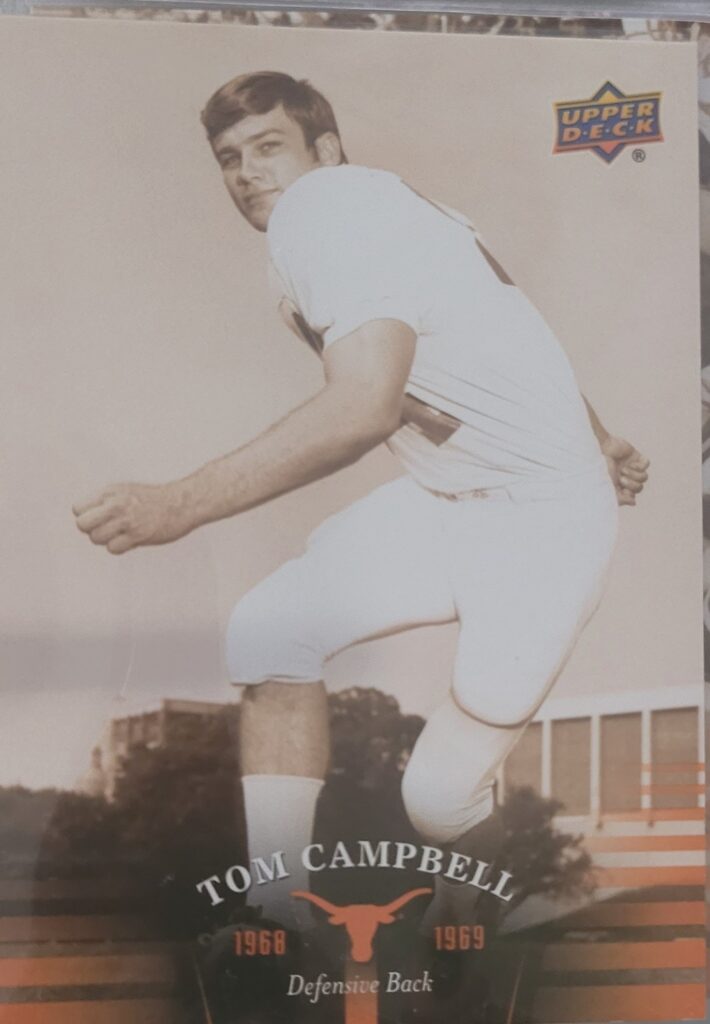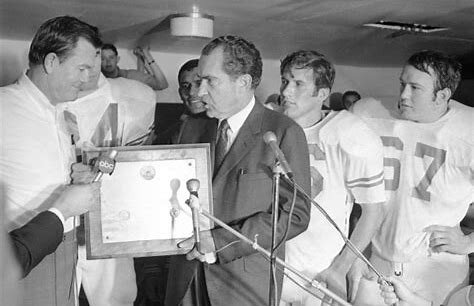42 Home wins in a Row by Larry Carlson
HOME, AND COOKIN’ !
When The Horns Hooked 42 Straight
by Larry Carlson https://texaslsn.org
It was quite a damn feat, this Texas-sized home winnin’ streak. For those who know history, it stretched from when LBJ resided in the White House through the week in which Jimmy Carter was elected to the oval office. More than eight full years. That’s dog years in football seasons, amigo.
From the week when the Beatles’ “Hey, Jude” topped the Billboard charts — followed closely by an eclectic top ten that included O.C. Smith’s “Little Green Apples” and Jeannie C Reilly’s “Harper Valley PTA” — to when Texas-ex Steve Miller had the number one song, “Rockin’ Me” and KC & The Sunshine Band and Wild Cherry were banging the dance floors with “Shake Your Booty” and “Play That Funky Music (White Boy),” respectively.
What I’m riffin’ about here is the greatest — by miles — home-winning streak in Longhorn football history. It spanned from Oct. 5, 1968 to Nov. 6, 1976.
America experienced Neil Armstong’s “giant leap,” Teddy Kennedy’s “Chappaquiddick,” the Manson murders and Woodstock between UT’s first four victories in the chain (1968) and the start of the next season, just nine months later. But life would not always be so unsettled.
Along the way, there were reassuring constants in the world, at least for UT fans.
Darrell Royal. The wishbone. Burnt orange jerseys. The Longhorns at home.
Sure bets, the kind never available in Vega$.
Think about it. The remarkable string of Texas W’s included the last four home games of one season, all home games the next seven years, then the first two of another. Forty-two straight victories.
Two national championships. Six straight SWC titles with Cotton Bowls plus two other bowl teams and a shared conference crown. The aforementioned James Street. Steve Worster. Corby Robertson, Glen Halsell and Scott Henderson. Cotton Speyrer. Eddie Phillips. Greg Ploetz.
Jerry Sisemore. Alan Lowry. Bill Wyman and Roosevelt Leaks. Doug English. Marty Akins. And a dude named Earl Campbell.

1968 Corby Robertson 
1969 backfield- Street, Bertelsen , Dale, Worster, and Koy 
1969 National Championship offense 
1969 Bobby Wuensch 
1969 Bill Atessis 
1969 Tom Campbell 
1970 Cotton Speyrer 
1970 Eddie Phillips against UCLA 

1969 David Arledge , Bill Atessis, and Scott Henderson 
1971 Roy Leaks 
1970 Bill Wyman 
Doug English 
Marty Akins injured 
Marty Akins 
Earl Campbell
All-Americans and all-stars aplenty. Old, gray Memorial Stadium was where the magic happened. The weather could vary. Plenty of sticky September evenings when students couldn’t wait to refresh at the Broken Spoke, Posse East, Hole In The Wall or other retreats. And there were hot, sunburned afternoons, rainy nights and at least one windy, overcast, freezing day.
Texas began the streak with James Street’s first start. Coming off three very frustrating, very disappointing 6-4 seasons, the Steers underwhelmed in the home opener against formidable Houston. The birth of the wishbone was sourly christened with a sister-kissing 20-20 tie. Seven days later, UT lost to Tech in Lubbock with the offense only showing signs of life in the second half, after Street came off the bench.
On the first weekend of October, Texas dispatched Oklahoma State, 31-3, with the new QB1, Street, in the saddle. He tossed TD passes to Speyrer and erstwhile QB-about-to-be-star-safety Bill Bradley. Future UT Athletic Director Mike Perrin chipped in a pick six. So Texas was 1-1-1. Nothing to write home about from the spartan surroundings of Moore-Hill Hall.But then the Horns earned a last-minute comeback win over OU in Dallas. A week later, Texas manhandled Arkansas in Austin. Two in a row at home. The future was coming into focus
It’s not like there weren’t any rocky patches on the superhighway to forty-two straight. Sure, there were blowouts of Navy (56-17), TCU (69-7) and many more. There were ho-hum, non-conference yawners over the lowly likes of Utah State and Wake Forest. Plenty of never-in-doubt wins against downtrodden SWC whipdogs such as Rice, SMU and Baylor. Occasionally, though, there was drama.

Speyrer touchdown catch 
1970 Billy Dale and Jim Achilles, UCLA 
1970 Eddie Phillips against UCLA 
1970 Cotton Speyrer 
1970 Phillips, Dale, Worster, Bertelsen 
1969 and 1970 National Champions
Texas had been mashing foes by ungodly margins for two years when UCLA came to town in early October 1970 to challenge the top-ranked defending national champs. Twenty-two straight wins now, ten of them at home, sweet Memorial Stadium. Uncharacteristically for early autumn, it was a day game. Major renovations were underway, with an upper deck and new press box under construction. Lights out, in more ways than one.
UCLA coach Tommy Prothro brought a defense that confounded the wishbone by mirroring each UT backfield member, and disguising the scheme very well. The Bruins also featured Dennis Dummitt, a West Coast quarterbackin’ man the likes of which Texas had not seen. He threw for a dazzling 340 yards in an era in which 150 yards marked a big day. Somehow, Texas trailed just 17-13 late in the game. Talk to Longhorn fans, even those who weren’t yet born in 1970, and they were all there that day. To be sure, they had all also attended the Philadelphia-New York game when Wilt “The Stilt” Chamberlain poured in 100 points. Had been at Yankee Stadium when Maris hit his 61st. And they would later witness Clint Longley’s Thanksgiving pass to Drew Pearson to scalp the Redskins in ’74.
Back to Memorial Stadium, though. Texas had its fourth quarter chances against the Angelinos and came up dry. Until it was 3rd-and-19 in the final minute. That’s when Cotton Speyrer somehow got between members of a suddenly befuddled UCLA secondary. When he crossed the stripe on a 45-yard miracle touchdown pass from Eddie Phillips, just a dozen ticks remained. Pandemonium had been re-defined, Texas style.
UT 20, UCLA 17.
The overall win streak would stretch to 30, ending on Jan. 1 of the following year in Big D. But the uninterrupted web of home W’s was just getting warmed up at eleven.
It was all breathers in ’71. Texas outscored five visiting opponents, 157-17.
A fiery defense, paced by Greg Ploetz, Ray Dowdy, Randy Braband and Alan Lowry pitched three hometown shutouts.

1971 Greg Ploetz 
1970 Ray Dowdy 
1972 Randy Braband #63 
1970 Randy Braband
Highlights at home in ’72 included a three-touchdown butt-kicking of #17 Arkansas in a nighttime downpour and a 38-3 laugher over hapless A&M. It was UT’s fourth straight 5-0 worksheet in Austin. The Horns would go on to beat Bama in the Cotton Bowl and finish third in the national rankings.
The ’73 Horns again went unbeaten in SWC play, chalking up a sixth straight championship. In five home games, Texas outscored oopponents by a 43-7 average. All-America FB Roosevelt Leaks provided the offensive punch and All-Conference defenders Glenn Gaspard, Jay Arnold, Malcolm Minnick, Bill Rutherford and Doug English roughed up every visiting squad.

1973 Glen Gaspard 
Malcolm Minnick and Jay Arnold 
1973 Yeoman, Arnold, Tresch 
Jay Arnold
The following autumn, road losses to Tech (September) and Baylor (November) foiled UT’s quest for a seventh consecutive SWC title. But the Steers were still invincible at Memorial Stadium, beating Wyoming and Washington and then stomping Arkansas, 38-7, and SMU, 35-15. Following the debacle in Waco, a 6-4 Texas squad was at a crossroads of sorts.
The Horns closed out the road sked in chilly Fort Worth and made an emphatic statement, setting a SWC scoring record while annihilating TCU, 81-16. The day after Thanksgiving, Texas had the challenge of trying to prevent A&M from possibly wresting a Cotton Bowl host spot from Baylor.
The men in burnt orange were ready. Just 54 seconds into the game — played in bitter cold and windy weather — it was all over but the crying for the Aggies. Texas converted two A&M fumbles into quick touchdowns for a 14-zip first-minute lead.
Four minutes later, another Ag mishap helped UT to a 17-0 margin. The Longhorns cruised to a 32-3 victory, got a Gator Bowl bid and left the Farmers in the cold, bowl-less for the 16th time in 17 seasons. The Longhorns’ home winning streak was now at 34 and counting.
The ’75 season marked the first time for the Longhorns to host six, not five, home games. The wishbone, operated by third-year QB Marty Akins, was in high gear with soph FB Earl Campbell alternately running over and past opponents. Texas averaged 50 points per game in Austin demolition derby matches with Colorado State, Texas Tech and Utah State. The Horns wrecked Rice, Baylor and TCU in their remaining home games, en route to a shared SWC title and a comeback victory over Colorado in Houston’s Astro-Bluebonnet Bowl. Akins utilized his senior season to break his 9-9 tie with the immortal James Street for most home wins by a starting QB during the ongoing streak. Now there were 40 home wins for the Longhorns. And fifteen had come with the strong and speedy Akins under center.
A quick look at the time capsule for the streak thus far. Richard Nixon won the ’68 presidential election. Then the aforementioned helter skelter year of 1969 was crazy, indeed. But it was quite perfect for University of Texas football. National championship-perfect.
So was 1970, though burnt orange-hued Beatles fans mourned the breakup of the Fab Four. And the deaths of Jimi Hendrix and former UT student, Janis Joplin. Protests against the war in Vietnam continued. So did the Texas wins, as calendar pages flew. Americans flocked to theatres for films such as “Butch Cassidy and The Sundance Kid,” “Billly Jack,” “Dirty Harry” and “The Godfather.”
Nixon was re-elected in a landslide victory. The war in Vietnam ended. Then Watergate happened and political turmoil ensued. But life went on.
There was even a college campus craze of nudity in tennis shoes, called “streaking,” during the spring of ’74. It was quickly celebrated in a novelty song by Ray Stevens. Fittingly, for Longhorn football followers, it was entitled, “The Streak.” The naked truth, at that time, flashed 29 consecutive home victories.
Nixon, who had presented the Longhorns with a national championship plaque — to the dismay of Joe Paterno and Penn State — back in December ’69, resigned from office prior to the 1974 gridiron season. Gerald Ford, a former Michigan Wolverine All-American, served as president for the remainder of the win skein, seeing it through America’s Bicentennial celebration and the early days of disco.

Okay, so much for the flashback. The future was now. September of ’76, the Longhorns made a shaky debut, far away from home, in Chestnut Hill, Massachusetts. Call it the second take of the Boston Massacre. The unheralded BC Eagles upset seventh-ranked Texas, 14-13.
The Longhorns no longer had the services of a three-year starter at QB. Instead, they were forced to rely upon a former walk-on to run the wishbone. And Earl Campbell was extremely limited by a hamstring injury that would bother him throughout the autumn. Texas was about to find out that a damn good defense could not do it all.
On a quiet jet flight back to Texas, senior All-American DB Raymond Clayborn — who had excelled earlier at UT as a halfback and return dynamo — gave Austin newspaperman Kirk Bohls one chilling statement. “It’s gonna be a long season,” Ray-Clay sighed.
It was, as the historians and authors like to say, a portent of things to come.
The Steers got home wins to run the Austin-based streak to 42, plucking low-hanging fruit suited up as North Texas, 17-14, and SMU, 13-12. These, unfortunately, were not your older brother’s Longhorns.
The new kid on the Southwest Conference block, the Houston Cougars, came to Austin on November 6, their first matchup with Texas as “conference kin.” Ominously, the last time the U of H had faced the Horns was in September ’68. That one ended in a 20-20 draw. That was UT’s last home game before the good guys reeled off 42 straight wins, custom made for a tower beaming burnt orange.
Upstart Houston was 5-2, ranked 19th. Texas, at 3-3-1, was incredibly still ranked 20th, a show of respect for the Longhorn brand and for Darrell Royal. It turns out he would retire from coaching just one month later.
The Cougars led at halftime, 10-0. The Longhorns, as the script had gone all season, were kept afloat by an admirable defense. It featured freshmen who were future stars (Johnnie Johnson, Steve McMichael, Lance Taylor, Ricky Churchman, et al), a stellar junior tackle, Brad Shearer, and a fine crew of hardy seniors. That group included Clayborn, Bill Hamilton, Lionell Johnson, Rick Fenlaw, Ricky Burleson, Jim Gresham, Earnest Lee and Paul Jette.
By the end of the day, they would be worn out. Hamilton was in on 23 tackles, Johnson on 21. The Texas offense rushed for a depressing 24 yards on 36 tries, and could not keep the D off the field. When the south end’s scoreboard clock gave out, it was 30-0, Cougars. Texas players were bowed but not broken. Its fans were. This writer, then a first-year radio reporter out on the field, recalls being shoved rudely aside by a chesty, jubilant UH linebacker. Stupidly, I pushed back. Said the linebacker, “You want me to take this helmet off, and slam your head with it?” Retorted this then wispy, 6-2, 160 pounder, “You need the helmet?”
To this day, I am so very grateful that he shook his head at the crazy talk and joined his boisterous teammates in back-slapping, instead of body-slamming me.
Bottom line: The amazing race was over. Eight years, two months and 42 record-setting home victories had run their course. The astounding achievement, the fourth longest home win streak in modern college football history, was….history. Like many, I was there for the first victory, over Oklahoma State in ’68, for the final W in the chain, the ’76 squeaker over SMU, and for the loss that finished the run.
There have been other notable Austin win streaks by the Longhorns since then. One started just four weeks after the Cougar debacle. Texas beat Arkansas, 29-12, in what was the last hurrah for DKR and his best pal, Razorback coach Frank Broyles. The following fall, Fred Akers’ new-fangled Horns, with Big Earl running wild in the Veer/I sets, mauled visitors, 284-36 (46-6 per) in six home games.
In ’78, UT ran the new home streak to eleven with four more Austin triumphs, the biggest being a take-down of third-ranked Arkansas.
The streak hit the skids in November. The Houston Cougars did it again, 10-7.
The dudes from the Bayou City also cut down a 12-game rope that ran from ’82 and ’83 to halfway through ’84. Arkansas, en route to an unbeaten season, killed off another Longhorn streak of a dozen back in ’64. That chain included perfect home charts in ’62 and ’63, when a 10-0 mark at home was part of a 19-0-1 record over two regular seasons.
Longhorn football teams have built two very enviable home streaks in the 21st century. Texas put up W’s in its final four Austin matchups in ’03, then was perfect during the Rose Bowl run of ’04 and the national title season of 2005, adding one more home triumph in 2006 before Ohio State stopped the roll at 16.
A season later, UT launched a new lengthy victory train. It spanned another 16 triumphs — including a record seven home wins in 2008 — and came to a halt in 2010 when a 3-0 UT squad was spanked by visiting UCLA, 34-12. The Horns would then lose 6 of their last eight, signaling the start of a 13-year football purgatory.
All that, though, is merely now a long ago nightmare for Longhorn Nation.
Two straight years of the playoffs and chasing a fifth national championship will do that to a fan base. Maybe the latest home win streak is underway and revving up.
(TLSN’s Larry Carlson is a member of the Football Writers Association of America. He teaches sports media at Texas State University. Write him at lc13@txstate.edu)

